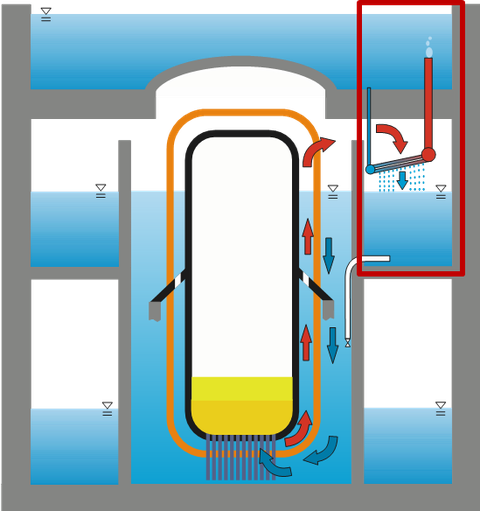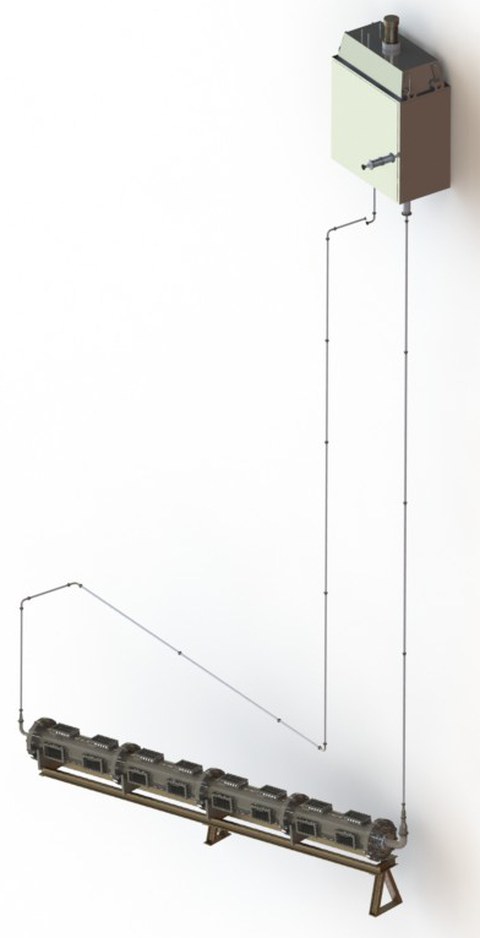PANAS
| Joint Research Project: “Investigation of passive systems for decay heat removal: Experimental analysis, modeling und validation for system- and CFD-Codes” within the framework of the BMBF funding concept “Basic energy Research 2020+” (Grant reference: 02NUK041) |
Coordinator:
Technische Universität Dresden - Chair of Hydrogen and Nuclear Engineering (TUD-WKET)
Subprojects:
- Technische Universität Dresden - Chair of Hydrogen and Nuclear Engineering (TUD-WKET)
Single- and integral experiments as well as theoretical analysis for evaporation, condensation and two-phase natural circulation stabilities in passive heat removal system
- Technische Hochschule Deggendorf, Professur für Technische Thermodynamik und Energiesysteme (THD)
Single- and integral experiments as well as theoretical analysis for evaporation, condensation and two-phase natural circulation stabilities in passive heat removal system
- Framatome GmbH
Transformation of new models for evaporation, condensation and two-phase natural circulation stabilities in passive heat removal systems to industrial applications
- Helmholtz Zentrum Dresden Rossendorf – Institut für Fluiddynamik (HZDR)
Investigations to condensation processes within emergency condenser and numerical simulation of passive heat removal chain
Subcontractor:
- Gesellschaft für Anlagen- und Reaktorsicherheit (GRS) GmbH
Development and validation of condensation and evaporation models for the ATHLET system code
Term:
07/2015 - 12/2020
Funding:
BMBF
Project summary
In addition to proven active safety systems, Generation III+ and IV nuclear power plants are equipped with passive safety systems to ensure decay heat removal and thus nuclear safety at all times. The joint research project PANAS refers to the boiling water reactor KERENA as reference for typical passive safety systems.
During postulated accidents, passive systems are particularly suitable for safe decay heat removal from reactor vessel and condensation chamber as they do not require external energy supply for activation or operation. Thereby, they substantially contribute to the enhancement of nuclear safety. Passive systems investigated in the current study involve phase changes in the heat exchangers. Contrary to heat transfer systems without phase transition, the resulting condensation and evaporation processes and their impact on thermal hydraulics and stability have to be taken into account. If the water level within the reactor core decreases during the incident, the generated steam condenses in the emergency condenser inside of slightly inclined tubes. The heat is transferred from the cooling loop of the reactor to a flooding pool. If the energy supply cannot be interrupted, the water of the flooding pool begins to evaporate. In this case, the main part of the generated steam condenses on the surface of the inclined tubes of the containment cooling condenser. If boiling temperature is attained, the water in the riser of the containment cooling condenser may evaporate. This threatens the stability of natural circulation. Instabilities such as flashing and geysering may cause strong mass flow fluctuations within the system, inducing mechanical overload of the components.
Fig. 1: Scheme of reactor concept KERENA with the containment cooling condenser (red marked) [Source: AREVA]
The test facility GENEVA (cf. Fig. 1) was designed by the chair of hydrogen and nuclear energy of the Technische Universität Dresden (TUD-WKET) and was derived from the containment cooling condenser included in the reactor concept KERENA (cf. Fig. 2). The main dimensions were kept true to scale (1:1) in order to genuinely reproduce the thermal hydraulic processes. The test facility was commissioned at the beginning of the year 2013. Since then numerous experiments regarding the natural circulation stability were carried out. Currently, a significant improvement of the instrumentation of the test facility is planned to allow for detailed investigations of the heat transfer processes due to condensation on the outside and evaporation in the inside of the inclined tubes.
Fig. 2: Test facility GENEVA for experimental investigation of two-phase natural circulation as replication of the containment cooling condenser included in the reactor concept KERENA [Source: TUD]
The obtained experimental data are used for verification and validation of the heat transfer models implemented in the system code ATHLET. Entirely new models may be created as well. Furthermore, the data are made available for comparison with CFD simulations carried out by other project partners.
In general, the stability of mass flows in circuits with two-phase natural circulation may be threatened as demonstrated by the GENEVA experiments. These potential deficiencies in stability will be modeled and investigated in detail by the RAM-ROM-Method developed by the TUD-WKET. The main advantage of this method is the implementation of non-linear algorithms. This is necessary as some mass flow characteristics that are obvious from experimental data are not accessible by linear analysis. Integral experiments performed on the GENEVA test facility will provide the required data.



